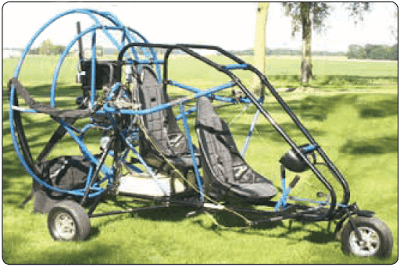A powered parachute has a carriage very similar to the weight-shift control aircraft. Its wing, however, has no support structure or rigidity and only takes on the shape of an airfoil when it is inflated by the blast of air from the propeller and the forward speed of the aircraft. In Figure 1, a powered parachute is on its approach to land with the wing fully inflated and rising up above the aircraft. Each colored section of the inflated wing is made up of cells that are open in the front to allow air to ram in, and closed in the back to keep the air trapped inside. In between all the cells there are holes that allow the air to flow from one cell to the next, in order to equalize the pressure within the inflated wing.
The wing is attached to the carriage of the aircraft by a large number of nylon or Kevlar lines that run from the tips of the wing all the way to the center. The weight of the aircraft acting on these lines and their individual lengths cause the inflated wing to take its shape. The lines attach to the body of the aircraft at a location very close to where the center of gravity is located, and this attachment point is adjustable to account for balance changes with occupants of varying weights.
As in weight-shift control aircraft, the powered parachute does not have the traditional flight controls of a fixed-wing airplane. When the wing of the aircraft is inflated and the aircraft starts moving forward, the wing starts generating lift. Once the groundspeed is sufficient for the wing’s lift greater than the weight of the aircraft, the aircraft lifts off the ground. Unlike an airplane, where the pilot has a lot of control over when the airplane rotates by deciding when to pull back on the yoke, the powered parachute will not take off until it reaches a specific airspeed. The powered parachute will typically lift off the ground at a speed somewhere between 28 and 30 mph, and will have airspeed in flight of approximately 30 mph.
Once the powered parachute is in flight, control over climbing and descending is handled with engine power. Advancing the throttle makes the aircraft climb, and retarding the throttle makes it descend. The inflated wing creates a lot of drag in flight, so reducing the engine power creates a very controllable descent of the aircraft. The throttle, for controlling engine power, is typically located on the right-hand side of the pilot. [Figure 2]
Once the powered parachute is in flight, control over climbing and descending is handled with engine power. Advancing the throttle makes the aircraft climb, and retarding the throttle makes it descend. The inflated wing creates a lot of drag in flight, so reducing the engine power creates a very controllable descent of the aircraft. The throttle, for controlling engine power, is typically located on the right-hand side of the pilot. [Figure 2]
Turning of the powered parachute in flight is handled by foot-operated pedals, or steering bars, located at the front of the aircraft. These bars can be seen in Figure 2. Each foot-operated pedal controls a set of lines, usually made from nylon that runs up to the trailing edge of each wingtip. When the right foot pedal is pushed, the line pulls down on the tailing edge of the 8 wingtip. As the trailing edge of the right wing drop downs, drag is increased on the right side and the aircraft turns right. When pressure is taken off the foot pedal, the drag in the entire airfoil equalizes and the aircraft resumes its straight-and-level flight.
To land a powered parachute, the first action the pilot takes is to reduce engine power and allow the aircraft to descend. With the power reduced to idle, the aircraft will descend at a rate of approximately 5 to 10 fps. As the aircraft approaches the ground, the descent rate can be lessened by increasing the engine power. Just before touchdown, the pilot pushes on both foot-operated pedals to drop the trailing edges on both sides of the wing. This action increases the drag on the wing uniformly, causing the wing to pivot aft, which raises the wing leading edge and increases the angle of attack and lift.
In Figure 3, the pilot is pushing on both foot pedals and the left and right wing trailing edges are deflected downward. The aircraft has just touched down and the wing is trailing behind the aircraft, caused by the high angle of attack and the additional drag on the wing.
In Figure 3, the pilot is pushing on both foot pedals and the left and right wing trailing edges are deflected downward. The aircraft has just touched down and the wing is trailing behind the aircraft, caused by the high angle of attack and the additional drag on the wing.
The increase in lift reduces the descent rate to almost nothing, and provides for a gentle landing. If the pilot pushes on the foot pedals too soon, the wing may pivot too far aft before touchdown resulting in an unacceptable descent rate. In that case, it might be a relatively hard landing.
RELATED POSTS
RELATED POSTS
- Aircraft Theory of Flight (Part 1)
- Aircraft Stability - Aircraft Theory of Flight (Part 2)
- Flight Control Surfaces - Aircraft Theory of Flight (Part 3)
- High Speed Aerodynamics - Aircraft Theory of Flight (Part 4)
- Helicopter Aerodynamics - Aircraft Theory of Flight (Part 5)
- Weight-Shift Control, Flexible Wing Aircraft Aerodynamics - Aircraft Theory of Flight (Part 6)
- Aerodynamics and the Laws of Physics
- Physics for Aviation



